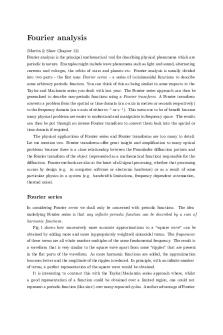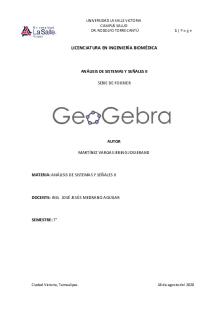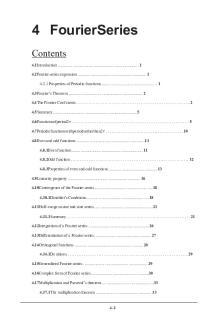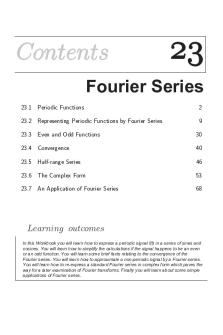Fourier Series Notes - MMU Department of Mathematics & Applied Mathematics PDF

| Title | Fourier Series Notes - MMU Department of Mathematics & Applied Mathematics |
|---|---|
| Author | Chevandré Louw |
| Course | Transform Theory |
| Institution | Nelson Mandela University |
| Pages | 36 |
| File Size | 1017.9 KB |
| File Type | |
| Total Downloads | 92 |
| Total Views | 149 |
Summary
MMU Department of Mathematics & Applied Mathematics ...
Description
4 FourierSeries Contents 4.1Introduction .............. ................... ................... ...................... . 1 4.2Fourier series expansion ............ ................... ................... .............. 1 4.2.1 Properties of Periodic functions ........ ..................... .................... .. 1 4.3Fourier’s Theorem ............ ................... ................... ................... 2 4.4The Fourier Coef cients. . . . . . . . . . . . . . . . . . . . . . . . . . . . . . . . . . . . . . . . . . . . . . . . . . . . . . . . . . . . . . . .2 4.5Summary.......... .................... ...................... ................... .......5 4.6Functionsofperiod2 . . . . . . . . . . . . . . . . . . . . . . . . . . . . . . . . . . . . . . . . . . . . . . . . . . . . . . . . . . . . . . . . . . 5 4.7Periodicfunctionswithperiodsotherthan2 . . . . . . . . . . . . . . . . . . . . . . . . . . . . . . . . . . . . . . . . . . . 10 4.8Even and odd functions ............ ................... ................... ............. 11 4.8.1Even function ........ ................... ................... .................... 11 4.8.2Odd function . . . . . . . . . . . . . . . . . . . . . . . . . . . . . . . . . . . . . . . . . . . . . . . . . . . . . . . . . . . . . . . . . . 12 4.8.3Properties of even and odd functions ............ ..................... ............ 13 4.9Linearity property ............... ...................... ................... ............ 16 4.10Convergence of the Fourier series........ ...................... ................... .....18 4.10.1Dirichlet’s Conditions ............ .................... ..................... .... 18 4.11Half–range cosine and sine series ...... ...................... ................... ....... 21 4.11.1Summary . . . . . . . . . . . . . . . . . . . . . . . . . . . . . . . . . . . . . . . . . . . . . . . . . . . . . . . . . . . . . . . . . . . . . 21 4.12Integration of a Fourier series. ................... ...................... ............... 26 4.13Differentiation of a Fourier series. ................... ...................... ........... 27 4.14Orthogonal functions ............ ...................... ................... ........... 28 4.14.1De nitions . . . . . . . . . . . . . . . . . . . . . . . . . . . . . . . . . . . . . . . . . . . . . . . . . . . . . . . . . . . . . . . . . . . 29 4.15Generalized Fourier series . ................... ...................... .................. 29 4.16Complex form of Fourier series..................... ...................... ............30 4.17Multiplication and Parseval’s theorem..... ...................... ................... ...33 4.17.1The multiplication theorem .................... .................... ............ 33
4–1
Chapter 4
Fourier Series
4.17.2Parseval’s theorem ........ ................... ...................... ........... 34
4.1 Introduction Therepresentationofafunctionintheformofaseriesis fairlycommonpracticeinmathematics. Probablythemostfamiliarexpansionsarepowerseriesoftheform i ({) =
" X
dq {q
q=X
inwhichtheresolvedcomponentsorbasesetcomprisethepowerfunctions 1> {> {2 > {3 > = = = > {q > = = =
Forexample, h{ = 1 + { +
" X {q {q {2 {3 + + === + + === = 2! 3! q! q! q=0
NotallfunctionscanbeexpressedasaMaclaurin’sseries,e.g. i ({) = {= Powerfunctionscomprise onlyoneexampleofabasesetfortheexpansionoffunctions. Inparticular,a Fourierseriesisan 2 expansionofaperiodicfunctioni ({) ofperiodW = inwhichthebasesetisthesetofsine $ functions,givinganexpandedrepresentationoftheform i ({) = D0 +
" X
Dq sin(q${ + !q )
q=1
AnadvantageofFourier’sseriesisthatitcanrepresentafunctioncontainingdiscontinuities. In manyengineeringproblems,however,wehavetodealwithperiodicfunctions.
4.2 Fourierseriesexpansion 4.2.1 PropertiesofPeriodicfunctions Afunctioni ({) issaidtobeperiodicifitisrepeatedatregularintervals. i ({ + W ) = i ({)
We de ne the frequency of a periodic function to be the reciprocal of its period, so that frequency=
1 1 = period W
The term circular frequency is also used in engineering, and is de ned by circularfrequency= 2 × frequency=
2 W
andismeasuredinradianspersecond. Itiscommontodroptheterm‘circular’andrefertothis simplyasthefrequencywhenthecontextisclear.
4–2
Chapter 4
Fourier Series
4.3 Fourier’sTheorem This theorem states that a periodic function that satis es certain conditions can be expressed as the sumofanumberofsinefunctionsofdifferentamplitudes,phasesandperiods. Thatis,ifi ({) isa periodicfunctionwithperiodW then i ({) = D0 + D1 sin(${ + !1 ) + D2 sin(2${ + !2 ) + = = = + Dq sin(q${ + !q ) + = = =
wheretheD0 sand!0 s areconstantsand$ = 2@W isthefrequencyofi ({).Where: D1 sin(${ + !1 ) is called the rst harmonic or the fundamental mode, and it has the same
frequency$ astheparentfunctioni ({). Dq sin(q${ + !q ) iscalledthenth harmonic,andithasfrequencyq$,whichisq timesthatof
thefundamental. Dq denotestheamplitudeofthenth harmonicand!q isitsphaseangle,measuringthelagorlead
ofthenth harmonicwithreferencetoapure sinewaveofthesamefrequency. Since Dq sin(q${ + !q ) = (Dq cos !q ) sin q${ + (Dq sin !q ) cos q${ = eq sin q${ + dq cos q${
where eq = Dq cos !q > dq = Dq sin !q " X d0 theexpansionmaybewrittenasi ({) = + (dq cos q${ + eq sin q${) whered0 = 2D0 . 2 q=1 TheexpansioniscalledtheFourierseriesexpansionofthefunctioni ({),andthedv andev are
calledtheFouriercoef cients.
4.4 The Fourier Coef cients Thefollowingintegrals,inwhichW = 2@$ areveryimportant. ; A ? 0 q= 6 0 R f+W 1. f cos q${ g{ = A = W q=0 2.
3.
4.
5.
R f+W f
R f+W f
R f+W f
R f+W f
sin q${ g{ = 0
;q ; A ?0 sin p${ sin q${ g{ = A = 1W 2 cos p${ cos q${ g{ =
; A ? 0
A = 1W 2
cos p${ sin q${ g{ = 0
p 6= q p = q 6= 0 p 6= q p = q 6= 0 ; p andq
4–3
Chapter 4
Fourier Series
The following de nite integrals does pop up a lot when we use Fourier series. The numbers p andq occurringintheseformulaeareintegersotherthanzero. Asanexercise,PROVEthem. R ;q 1. 3 sin q{g{ = 0
2.
3.
4. 5.
R
3
R
0
R
0
sin q{g{ = 0
sin q{g{ =
; A ? 0
A = 2 q
cos q{g{ = 0
R
3
;q
;q even ;q odd ;q
cos2 q{g{ =
q 6= 0
R
sin q{ cos p{g{ = 0 ; q andp ; A ? 0 q 6= p R 7. 3 cos q{ cos p{g{ = A = q=p
6.
8.
3
R
3 sin q{ sin p{g{ =
; A ?0
A =
q 6= p q=p
Exercise 1 Evaluatethefollowingintegrals: R 1. 0 { sin q{g{ 2. 3. 4.
R
0
R
0
R3
0
ANSWERS ¸ 2 2 > q odd; > q even q q ¸ 1 2 > q odd;0> q even q ¸ 4 > q odd;0> q even q ¸ 54 54 > q odd; 2 2 > q even q q2 2
{ cos q{g{ { sin q{g{ {2 cos
R 2
³ q{ ´ 3
sin q{g{
g{
Theresultsconstitutetheorthogonalityrelationsforsineandcosinefunctions,andshowthattheset offunctions {1> cos ${> cos 2${> = = = > cos q${> sin ${> sin 2${> = = = > sin q${}
isanorthogonalsetoffunctionsontheintervalf { f + W . Thechoiceoff isarbitraryinthese results,itonlybeingnecessarytointegrateoveraperiodofdurationW .
4–4
Chapter 4
Fourier Series
Integratingtheserieswithrespectto{ overtheperiod{ = f to{ = f + W ,,wehave ¶ Z f+W Z f+W " X 1 Z f+W µ Z f+W i ({)g{ = cos q${g{ + e sin q${g{ g{ + q d0 dq f f f f 2 q=1 " X 1 [dq (0) + eq (0)] = d0 (W ) + 2 q=1 =
1 W d0 2
Thus
d0
andwecanseethattheconstantterm
Z 1 1 g+W i ({)g{ d0 = 2 W g 2 intheFourierseriesexpansionrepresentsthemeanvalueof
thefunctioni ({) overoneperiod. Hence 2 W
d0 =
Z
f+W
i ({)g{
f
Toobtainthisresult,wehaveassumedthatterm-by-termintegrationoftheseriesispermissible. Thisisindeedsobecauseoftheconvergencepropertiesoftheseries. Moreaboutorthogonalityand convergence later. We rst put our attention on determining the Fourier series expansion of a given periodicfunctioni ({) = To obtain the Fourier coef cient dq (q 6= 0),wemultiplythroughoutbycos p${ andintegratewith respectto{ overtheperiod{ = f to{ = f + W ,giving Z f+W Z f+W Z f+W " X 1 cos q${ cos p${g{ cos p${g{ + i ({) cos p${g{ = d0 dq 2 f f f q=1 Z f+W " X cos p${ sin q${g{ + eq q=1
f
the only non-zero integral on the right-hand side is the one that occurs in the rst summation when q = p. Thatis,wehave Z Z f+W i ({) cos p${g{ = dp
f+W
f
f
giving
2 dp = W
which,onreplacingp byq,gives dq =
2 W
Z
Z
1 cos p${ cos p${g{ = dp W 2
f+W
i ({) cos p${g{
f
f+W
i ({) cos q${g{
(q = 0> 1> 2> = = =)
f
Thevalueofd0 maybeobtainedbytakingq = 0 d0 =
2 W
Z
f+W
i ({)g{
f
To obtain the Fourier coef cients eq ,wemultiplythroughoutbysin p${ andintegratewithrespect
4–5
Chapter 4
Fourier Series
to{ overtheperiod{ = f to{ = f + W , Z f+W Z f+W " X 1 Z f+W i ({) sin p${g{ = d sin p${ cos q${g{ sin p${g{ + q d0 f f f 2 q=1 Z f+W " X eq sin p${ sin q${g{ === + f
q=1
Whenp = q,wehave Z f+W
i ({) sin p${g{ = ep
Z
f+W
sin p${ sin p${g{ =
f
f
giving,onreplacingp byq, eq =
2 W
Z
1 ep W 2
f+W
i ({) sin q${g{
(q = 1> 2> 3> = = =)
f
4.5 Summary Aperiodicfunctioni ({) ofperiodW = 2@$ canbeexpandedasaFourier seriesgivenby: "
X 1 i ({) = d0 + (dq cos q${ + eq sin q${) 2 q=1
where the coef cients are given by the Euler formulae Z 2 f+W i ({) cos q${g{ dq = W f Z 2 f+W eq = i ({) sin q${g{ W f
(q = 0> 1> 2> = = =) (q = 1> 2> 3> = = =)
ThelimitsofintegrationinEuler’sformulaemaybe speci ed over any period,thechoiceoff is arbitrary.Sometimes i ({) arespecifyovereithertheperiod 1
0 ? { ? W ,sothatthelimitsofintegrationis 1
2W
2W
? { ? 12 W ortheperiod
to 1 2 W (i.e.f = 12 W )or0 toW (i.e.f = 0).
4.6 Functionsofperiod2 Example4.1 ObtaintheFourierseriesexpansionoftheperiodicfunctioni ({) ofperiod2 de ned by
i ({) = {
(0 ? { ? 2)>
i({) = i ({ + 2)
Solution. Asketchofthefunctioni ({) overtheinterval4 ? { ? 4 isshown.
Sincethefunctionisperiodicweonlyneedtosketchitoveroneperiod,thepatternbeingrepeated 4–6
Chapter 4
Fourier Series
for other periods. Evaluating the Fourier coef cients d0 anddq gives d0 =
1Z
2
i ({)g{ =
0
1Z
2
{g{ =
0
¸ 1 {2 2 = 2 2 0
and Z
1
dq =
Z
1
=
2
i ({) cos q{g{
(q = 1> 2> = = =)
0 2
{ cos q{g{ 0
¸ cos q{ 2 1 sin q{ + = { q q2 0 ¶ µ cos 0 1 1 2 sin 2q + 2 cos 2q 2 = q q q = 0
sincesin 2q = 0 andcos 2q = cos 0 = 1. Notetheneedtoworkoutd0 separatelyfromdq .For eq : eq
1 = =
1
Z
Z
2
i ({) sin q{g{
(q = 1> 2> = = =)
0 2
{ sin q{g{ 0
¸ sin q{ 2 { 1 = cos q{ + q q2 0 =
1 2 ( cos 2q) q
=
2 q
[sin 2q = sin 0 = 0]
[cos 2q = 1]
TheFourierseriesexpansionofi ({) is i ({) =
" X 2 q=1
q
sin q{
= 2(sin { +
sin q{ sin 2{ sin 3{ + +=== + + = = =) 2 3 q
Example4.2 Aperiodicfunctioni ({) withperiod2 is de ned by i ({) = {2 + {
( ? { ? )>
i({) = i ({ + 2)
Solution. Sketchagraphofthefunctioni ({) for valuesof{ from{ = 3 to{ = 3 andobtain aFourierseriesexpansionofthefunction.
4–7
Chapter 4
Fourier Series
where 1
d0 =
1
=
Z
i ({)g{
3 Z
2 ({2 + {)g{ = 2 3 3
and dq = =
1 1
1 =
Z
i ({) cos q{g{
3 Z
({2 + {) cos q{g{
3 2 {
q
sin q{ +
1 4 = cos q q2 =
(q = 1> 2> 3> = = =)
4 (1)q q2
¸
¸ 2{ 2 { 1 sin q{ + cos q{ sin q{ + cos q{ q2 q3 q q2 3 [sin q = 0]
[cos q = (1)q ]
and eq
1 = =
1
Z
i ({) sin q{g{
3 Z
(q = 1> 2> 3> = = =)
({2 + {) sin q{g{
3
2 ¸ 2{ 2 { 1 { 1 cos q{ + 2 sin q{ + 3 cos q{ cos q{ + 2 sin q{ = q q q q q 3
2 = cos q q 2 = (1)q q
[cos q = (1)q ]
TheFourierseriesexpansionofi ({) is i ({) = =
" " X 2 1 2 X 4 q (1)q sin q{ ( 1) cos q{ + 2 q q 3 q=1 q=1 ¶ ¶ µ µ 1 2 sin 3{ sin 2{ cos 2{ cos 3{ + + = = = + = = = + 2 sin { + 4 cos { + 2 22 3 32 3
4–8
Chapter 4
Fourier Series
Usingthecomplexform,analternativeapproach,gives(Thismethodwill bedonelaterinthis section) dq + meq =
1
Z
i ({)hmq{g{ =
3
1
Z
({2 + {)hmq{g{
3 Z
µ 2 ¸ ¶ 2{ + 1 mq{ 1 { + { mq{ h h g{ mq mq 3 3 ¸ 1 {2 + { mq{ 2{ + 1 mq{ 2hmq{ = h h + mq (mq)2 (mq)3 3
=
Since hmq = cos q + m sin q = (1)q h3mq = cos q m sin q = (1)q 1@m = m
Equatingrealandimaginarypartsgives,asbefore, dq =
4 (1)q > q2
2 eq = (1)q q
Aperiodicfunctioni ({) may be speci ed in a piecewise fashion over a period, or, indeed, it may only be piecewise-continuous over a period. In order to calculate the Fourier coef cients in such cases,itisnecessarytobreakuptherangeofintegrationintheEulerformulaetocorrespondtothe variouscomponentsofthefunction. Example4.3 Aperiodicfunctioni ({) ofperiod2 is de ned within the period 0 { 2 by ; A A A { if 0 { 12 A A ? 1 i ({) = if 12 { 2 A A A A A = 1 { if { 2 2 Sketchagraphofi ({) for2 { 3 and nd a Fourier series expansion of it.
Solution. Agraphofthefunctioni ({) for2 { 3 isshown,
4–9
Chapter 4
Fourier Series
where d0 =
1Z
2
i ({)g{ =
0
" 1 Z
@2
{g{ +
0
Z
@2
1 2
g{ +
Z
2
(
1 2
#
5 {)g{ = 8
and Z
1
dq =
2
i ({) cos q{g{
Z Z 2 Z 1 1 1 @2 { cos q{g{ + cos q{g{ + ( {) cos q{g{] [ 2 0 @2 2 Ã ¸ ! h i i h 2 { sin q{ cos q{ 2 cos q{ @2 { 1 + + sin q{ + sin q{ q 2q q2 0 2q2 @2 q 2 ¶ µ 1 1 1 1 1 1 1 1 sin q 2 + 2 cos q sin q + 2 cos q 2 2q 2q 2q q q 2q 2 2 2
= = =
1 1 (2 cos q 3 + cos q) 2 2q2
=
thatis, dq =
and eq =
1
=
1
=
1
=
1
=
=
Z
; A ?
1 q@2 q2 [(1)
A = 2 q2
1]
even q odd
q
2
"0Z
i ({) sin q{g{
(q = 1> 2> 3> = = =)
# Z 2 1 1 sin q{g{ + ( {) sin q{g{ { sin q{g{ + 2 0 @2 2 Ã ¸2 ! ¸@2 h i { 2 1 1 { + cos q{ + cos q{ + 2 sin q{ cos q{ 2 sin q{ 2q q 2q @2 2q q 0 µ ¶ 1 1 1 1 cos q cos q + 2 sin q cos q + cos q + 2q 2q 2 q 2 2q 2q 2 Z
@2
1 1 sin q q2 2 ; A ? 0 A =
(q = 1> 2> 3> = = =)
0
(31)(q1)@2 q2
; evenq ; oddq
TheFourierseriesexpansionofi ({) is i ({) =
5 2 cos 3{ cos 5{ + = = =) (cos { + + 52 16 32 2 cos 2{ cos 6{ cos 10{ + = = =) ( 2 + + 102 2 62 1 sin 3{ sin 5{ sin 7{ + (sin { + = = =) + 72 32 52
4–10
Chapter 4
Fourier Series
4.7 Periodicfunctionswithperiodsotherthan2 If| = i ({) is de ned in the range o too andnotfrom to ,ithasaperiod2o i.e. i ({ + 2o) = i ({) = Wecanconvertthistoanintervalof2 bychangingthevalueoftheunitsofthe
independentvariable. Example4.4 DeterminetheFourierseriesfor ; A ? { for 4 ? { ? 0 i ({) = A = { for 0 ? { ? 4
andi ({ + 8) = i ({)
Solution. Here d0
1 = 4
Z
0
1 {g{ + 4 34
Z
4
{g{ 0
1 1 £ ¤4 1 1 £ 2 ¤0 = · { 34 + · {2 0 4 2 4 2 = 2+2 =4
and Z ³ q{ ´ 1 4 cos g{ (q = 1> 2> 3> = = =) g{ + 4 0 4 4 34 ( ) Z 0 ³ q{ ´ ³ q{ ´¸0 1 4{ 4 = sin g{ sin q q 34 4 4 4 34 ( ) Z 4 ³ q{ ´¸4 ³ q{ ´ 1 4{ 4 + sin sin g{ q 4 q 0 4 4 0 ³ q{ ´¸4 ³ q{ ´¸0 1 16 1 16 cos cos + = 4 q2 2 4 4 4 q2 2 0 34
dq =
1 4
Z
0
{ cos
³ q{´
8
(cos q 1) ; A A ? 16 q odd q2 2 = A A = 0 q even =
q2 2
4–11
Chapter 4 andeq = 0
Fourier Series
(FKHFN this!!!)
TheFourierseriesexpansionofi ({) is i ({) = 2 +
" X
8
(cos q 1) cos
³ q{ ´
4 q2 2 µ ¶ 5{ 1 3{ 1 { 16 cos + + cos +··· cos = 2 25 4 9 4 4 2 q=1
Exercise 2 Obtain the Fourier series for the functions de ned by: 1. i ({) = {2 >
0 ? { ? 2 andi ({ + 2) = i ({)
Sketchthegraphfor{ 5 [4> 4] ; A ? { + for ? { ? 0 2. i ({) = A =0 for 0 ? { ? Sketchthegraphfor{ 5 [3> 3] ; A ? 1 for 1 ? { ? 0 3. i ({) = A = { for 0 ? { ? 1
Sketchthegraphfor{ 5 [3> 3] ; A ?{ for 0 ? { ? 2 4. i ({) = A = { for ? { ? 2 Sketchthegraphfor{ 5 [> 2]
andi ({ + 2) = i ({)
andi ({ + 2) = i ({)
andi ({ + ) = i ({)
4.8 Evenandoddfunctions Aparticularfunctionpossessescertainsymmetricalpropertiesenablesusbothtotellwhichterms areabsentfromaFourierseriesexpans...
Similar Free PDFs

Fourier series Lecture Notes
- 24 Pages

Engineering Mathematics Notes
- 270 Pages

Mathematics of Circular Motion
- 3 Pages

Mathematics FORM ONE Notes
- 140 Pages

Mathematics Grade 10 Notes
- 183 Pages

the foundations of mathematics
- 409 Pages

Mathematics OF Finance MMW
- 5 Pages

Journal of Physical Mathematics
- 8 Pages

Mathematics of Love Final
- 27 Pages

The Mathematics of Poker
- 367 Pages

Series de Fourier
- 11 Pages
Popular Institutions
- Tinajero National High School - Annex
- Politeknik Caltex Riau
- Yokohama City University
- SGT University
- University of Al-Qadisiyah
- Divine Word College of Vigan
- Techniek College Rotterdam
- Universidade de Santiago
- Universiti Teknologi MARA Cawangan Johor Kampus Pasir Gudang
- Poltekkes Kemenkes Yogyakarta
- Baguio City National High School
- Colegio san marcos
- preparatoria uno
- Centro de Bachillerato Tecnológico Industrial y de Servicios No. 107
- Dalian Maritime University
- Quang Trung Secondary School
- Colegio Tecnológico en Informática
- Corporación Regional de Educación Superior
- Grupo CEDVA
- Dar Al Uloom University
- Centro de Estudios Preuniversitarios de la Universidad Nacional de Ingeniería
- 上智大学
- Aakash International School, Nuna Majara
- San Felipe Neri Catholic School
- Kang Chiao International School - New Taipei City
- Misamis Occidental National High School
- Institución Educativa Escuela Normal Juan Ladrilleros
- Kolehiyo ng Pantukan
- Batanes State College
- Instituto Continental
- Sekolah Menengah Kejuruan Kesehatan Kaltara (Tarakan)
- Colegio de La Inmaculada Concepcion - Cebu




